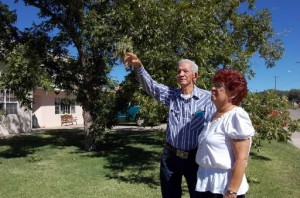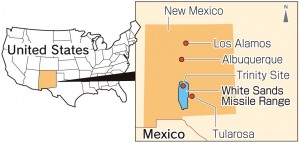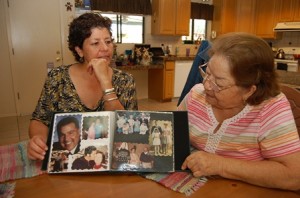Hiroshima Asks: Toward the 70th Anniversary of the Atomic Bombing: U.S. begins investigation of internal radiation exposure near first nuclear test site
Jan. 26, 2015
Abnormally high incidence of cancer among local residents
by Yumi Kanazaki, Staff Writer
The residents near Trinity Site have long suffered from poor health. Located in the U.S. state of New Mexico, this was the spot where the United States conducted its first nuclear test, on July 16, 1945, before attacking Hiroshima and Nagasaki with atomic bombs. Last September, a research team from that country’s National Cancer Institute (NCI) began investigating radiation doses from fallout in the area. Attention is on whether the United States will acknowledge that the first A-bomb victims in the world were produced in the United States. Seventy years have now passed since the atomic bombs were dropped. As handing down the memories of the atomic bombings to the next generation is at a difficult turning point, there are signs of change in the United States, where justification for the A-bomb attacks has been strong.
The people who live or have lived in Tularosa, a village located about 65 kilometers southeast of ground zero, and other nearby areas organized a residents’ group in 2005. Tina Cordova, 55, the head of the group and a thyroid cancer survivor, said, “Including those who were born after the war, it is obvious that there are abnormally high incidences of cancer and leukemia. We can’t think of any reason except for the internal exposure to radiation from consuming the food and water contaminated from the fallout.” Ms. Cordova, too, lost her father in 2013 after his nine-year battle against three different cancers including one in his mouth.
Henry Herrera, 80, from the same village, saw the mushroom cloud that day. “A few hours later, ash started to fall. I’m the only one alive to tell about it. Everyone else has died of cancer,” he said sadly.
At the time of the atomic test, residents were given false information. They were told that there was an explosion at the nearby ammunition depot on the Air Force Base and were not instructed to evacuate. They continued their self-sufficient way of life, as before, drinking milking from the cows that grazed on the grass, and hunting rabbits. They also collected rainwater to drink.
The United States has already enacted the Radiation Exposure Compensation Act (RECA) to pay compensation, in lump sums, to former employees at the atmospheric nuclear test site in Nevada and “downwinders” who lived in the surrounding areas, along with those who worked in uranium mines. The residents around Trinity Site are asking Congress to amend the Act to promptly include New Mexico for compensation.
At Trinity Site, the development of the atomic bombs was carried out in strict secrecy. Thus, compared to Nevada, where 100 atmospheric nuclear tests were conducted, not as much attention was paid to Trinity Site. However, in 2010, a report by the U.S. Centers for Disease Control and Prevention (CDC) points out the possibility of the significant health risks from internal exposure to radiation around the Site. The current investigation by the National Cancer Institute is the first full-scale health study involving the local residents.
According to Steven Simon, 65, a dosimetry expert, the investigation team is now interviewing nine residents who have lived in the area from the time of the atomic tests, asking them in detail about many things, including their dietary habits back then. The investigation will widen to study more subjects, as well as the differences among races and regions. Making use of a variety of data, such as information from the fallout areas, the team is seeking to estimate the doses of radiation that were received.
Whether this survey for research purposes will affect deliberations at the U.S. Congress is not known, however. Ms. Cordova wants to know what happened 70 years ago, but says there is little time left for the residents and that even if the study is unable to identify the health effects, this should not be made an excuse for delay in providing relief measures.
Keywords
Trinity Site
As part of the Manhattan Project, the U.S. effort to develop atomic bombs, the first nuclear test in human history was performed at Trinity Site. A plutonium bomb, the same type of weapon as the bomb dropped on Nagasaki, was placed at the top of an iron tower about 30 meters tall, then detonated. The explosive power was equal to 19 kilotons of TNT, greater than that of the Hiroshima bomb (about 15 kilotons), and the mushroom cloud rose to a height of about 11.5 kilometers above the ground. Even 200 kilometers away, glass reportedly shattered as a result of the shock wave.
(Originally published on January 5, 2015)










